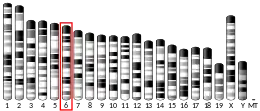HOXA2
Homeobox protein Hox-A2 is a protein that in humans is encoded by the HOXA2 gene.[5]
Function
In vertebrates, the genes encoding the class of transcription factors called homeobox genes are found in clusters named A, B, C, and D on four separate chromosomes. Expression of these proteins is spatially and temporally regulated during embryonic development. This gene is part of the A cluster on chromosome 7 and encodes a DNA-binding transcription factor which may regulate gene expression, morphogenesis, and differentiation. The encoded protein may be involved in the placement of hindbrain segments in the proper location along the anterior-posterior axis during development. Two transcript variants encoding two different isoforms have been found for this gene, with only one of the isoforms containing the homeodomain region.[6]
HOXA2 controls the embryonic development of the lower and middle part of the face and of the middle ear. Mutations in it are known to cause microtia, hearing impairment, and cleft palate.
See also
References
- GRCh38: Ensembl release 89: ENSG00000105996 - Ensembl, May 2017
- GRCm38: Ensembl release 89: ENSMUSG00000014704 - Ensembl, May 2017
- "Human PubMed Reference:". National Center for Biotechnology Information, U.S. National Library of Medicine.
- "Mouse PubMed Reference:". National Center for Biotechnology Information, U.S. National Library of Medicine.
- Scott MP (November 1992). "Vertebrate homeobox gene nomenclature". Cell. 71 (4): 551–3. doi:10.1016/0092-8674(92)90588-4. PMID 1358459. S2CID 13370372.
- "Entrez Gene: HOXA2 homeobox A2".
Further reading
- Alasti F, Sadeghi A, Sanati MH, et al. (2008). "A Mutation in HOXA2 Is Responsible for Autosomal-Recessive Microtia in an Iranian Family". Am. J. Hum. Genet. 82 (4): 982–91. doi:10.1016/j.ajhg.2008.02.015. PMC 2427268. PMID 18394579.
- Kosaki K, Kosaki R, Suzuki T, et al. (2002). "Complete mutation analysis panel of the 39 human HOX genes". Teratology. 65 (2): 50–62. doi:10.1002/tera.10009. PMID 11857506.
- Scherer SW, Cheung J, MacDonald JR, et al. (2003). "Human Chromosome 7: DNA Sequence and Biology". Science. 300 (5620): 767–72. Bibcode:2003Sci...300..767S. doi:10.1126/science.1083423. PMC 2882961. PMID 12690205.
- Hillier LW, Fulton RS, Fulton LA, et al. (2003). "The DNA sequence of human chromosome 7". Nature. 424 (6945): 157–64. Bibcode:2003Natur.424..157H. doi:10.1038/nature01782. PMID 12853948.
- Ota T, Suzuki Y, Nishikawa T, et al. (2004). "Complete sequencing and characterization of 21,243 full-length human cDNAs". Nat. Genet. 36 (1): 40–5. doi:10.1038/ng1285. PMID 14702039.
- Strausberg RL, Feingold EA, Grouse LH, et al. (2002). "Generation and initial analysis of more than 15,000 full-length human and mouse cDNA sequences". Proc. Natl. Acad. Sci. U.S.A. 99 (26): 16899–903. Bibcode:2002PNAS...9916899M. doi:10.1073/pnas.242603899. PMC 139241. PMID 12477932.
- Scott MP (1992). "Vertebrate homeobox gene nomenclature". Cell. 71 (4): 551–3. doi:10.1016/0092-8674(92)90588-4. PMID 1358459. S2CID 13370372.
- Yerges LM, Klei L, Cauley JA, et al. (2009). "High-Density Association Study of 383 Candidate Genes for Volumetric BMD at the Femoral Neck and Lumbar Spine Among Older Men". J. Bone Miner. Res. 24 (12): 2039–49. doi:10.1359/jbmr.090524. PMC 2791518. PMID 19453261.
- Apiou F, Flagiello D, Cillo C, et al. (1996). "Fine mapping of human HOX gene clusters". Cytogenet. Cell Genet. 73 (1–2): 114–5. doi:10.1159/000134320. PMID 8646877.



